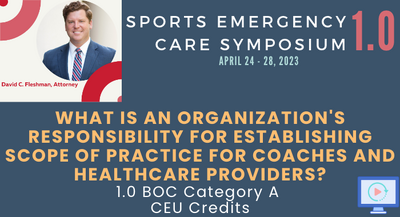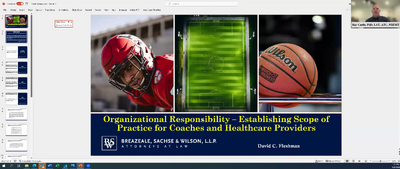Course Info (Description; Learning Objectives; Practice Gap; Clinical Bottom Line; Summary Conclusions)
Course Description:
The presentation titled "What Is An Organization's Responsibility for Establishing a Scope of Practice for Coaches and Healthcare Providers?" focuses on the critical elements of state practice acts, legal terminologies, and policies and procedures that define the responsibilities of coaches, athletic trainers, physicians, and other healthcare providers within a sports institution. This presentation aims to explore the legal consequences of not having structured documentation and guidelines for healthcare providers and coaches while providing medical services under the purview of athletic trainers for sports institutions.
BOC Domains of Athletic Training:
- Domain I - Risk Reduction, Wellness, and Health Literacy
- Domain V - Healthcare Administration and Professional Responsibility
Learning Objectives:
Upon completion of this course, participants will be able to:
- Examine significant operational and legal terminologies linked to sports medicine in connection with the dispensation of medical services under the purview of athletic trainers for sports institutions.
- Assess the elements of state practice acts and the significance of creating clearly written policies and procedures that define the extent of the duties of coaches, athletic trainers, and other healthcare providers operating within a particular state.
- Explore and evaluate different legal cases concerning a sports entity's fundamental obligation and accountability to establish guidelines, protocols, and systems that uphold the well-being and protection of its athletes.
- Determine and examine the legal consequences resulting from the absence of structured documentation that defines the responsibilities of physicians and the oversight of athletic trainers in carrying out their duties for sports institutions.
Practice Gap:
Despite the increasing importance of sports medicine and the role of healthcare providers in ensuring the well-being and protection of athletes, there is still a lack of structured documentation and guidelines defining the extent of the duties of coaches, athletic trainers, and other healthcare providers. The absence of clearly written policies and procedures could result in legal consequences and negatively impact the delivery of medical services.
Clinical Bottom Line:
Organizations have a fundamental obligation to establish guidelines, protocols, and systems that uphold the well-being and protection of athletes. This includes the creation of clearly written policies and procedures that define the responsibilities of coaches, athletic trainers, and other healthcare providers operating within a particular state. Failure to do so can result in legal consequences and negatively impact the delivery of medical services.
Summary Conclusions:
- The elements of state practice acts are significant in creating clearly written policies and procedures that define the extent of the duties of coaches, athletic trainers, and other healthcare providers operating within a particular state.
- Organizations have a fundamental obligation and accountability to establish guidelines, protocols, and systems that uphold the well-being and protection of its athletes.
- The absence of structured documentation that defines the responsibilities of physicians and the oversight of athletic trainers in carrying out their duties for sports institutions can result in legal consequences.
- Legal cases concerning a sports entity's obligation and accountability to establish guidelines, protocols, and systems that uphold the well-being and protection of its athletes should be explored and evaluated.
- The establishment of clearly written policies and procedures that define the responsibilities of coaches, athletic trainers, and other healthcare providers is critical to ensuring the well-being and protection of athletes.


